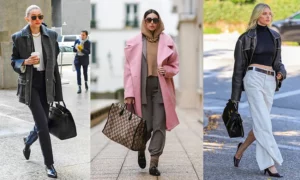New York, November – Tom’s Sons International Pleating has recently done an international television interview during New York Fashion Week where they discussed the history of their company and how they style various celebrities in pleats.
Pleats have been used by fashion designers and seamstresses to add volume, texture, and dimension to clothes since ancient Egypt. The dynamic folding technique is a hallmark in fashion today, from pleated front trousers to accordion-pleated skirts and dresses. Pleats are made by folding or doubling cloth and pressing, ironing, or creasing it into position. There are many different types of pleats, but the most frequent are side and box pleats, however they can also be accordion, cartridge, circular, curtain, draped, fluted, Fortuny, or French accordion.
Pleats are used to give a garment more volume. A wider silhouette is achieved by gathering or folding the fabric together. Pleats serve a practical as well as an aesthetic purpose, allowing for freedom of movement and airflow within a garment. Make sure to leave an additional seam allowance at the top while sewing pleats, since you’ll need more area to stitch and fold the pleats. For a pleated item, you’ll usually need a lot more fabric, so pay attention to the fabric requirements in the sewing design.
In a recent international TV interview, Tom’s Sons owner George Kalajian revealed that as everyone knows, many high brands shine in pleated products, but that is just the tip of the iceberg, and there is a more quiet and deeper cluster that supports it in New York and those are the workers who support the fashion industry. George continues to say: “I am extremely flattered to appear on this television program, especially in Japan, the home of the great pleater, Issey Myake. I have a lot of respect for his designs and techniques.”
Although technology has allowed them to speed up many processes in the supply chain, Lebanese pleat master Leon Kalajian and his son, George Kalajian, work together to produce hand crafted pleats that have been featured in the collections of Jason Wu, The Row, Proenza Schouler, and the Metropolitan Museum of Art. Tom’s and Sons International Pleating, a New York-based, family-run pleating business, has been supplying fashion designers and architectural organizations with pleating since 1931.
Meet George Kalajian
George Kalajian, who was born in Lebanon and raised in New York City, has a long history in the garment industry. His father founded Tom’s Sons in New York after his family came to the United States, specializing in fabric manipulation—the technique of pleating. George began his career there, but when his connection with his father deteriorated, he went away from New York and experimented with a variety of jobs. As his parents grew older, he felt compelled to carry on the family tradition and returned to the family business. He realized his passion and purpose by doing a 180.
George creates precise and complex pleats for some of the biggest brands in fashion, drawing on centuries of experience (including Marc Jacobs, Calvin Klein, Khaite, Ralph Lauren, Alexander Wang, Reem Acra). His work has been seen on the catwalks, in films, and even at the Metropolitan Museum of Art. But it was producing the authoritative book on the art of pleating—guiding up-and-coming designers with the precise procedures that can add another depth to their creativity and, eventually, unfurl into cutting-edge fashion—that gave him the most delight.
As mentioned above, Tom’s Sons is currently being run by George and Leon Kalajian. The duo has also published a book titled Pleating: Fundamentals for Fashion Design. The foundations of fabric pleating are covered in this concise book, which includes more than 300 pictures of pleated high-fashion designs and easy-to-follow diagrams demonstrating pleating techniques.. While their company specializes in couture evening wear and runway fashion, the concepts and definitions they lay out in this book can help anyone execute and convey designs appropriately. This is a must-have resource for fashion designers, seamstresses, pattern makers, customers, factory owners, students, and anybody else interested in the industry.


































